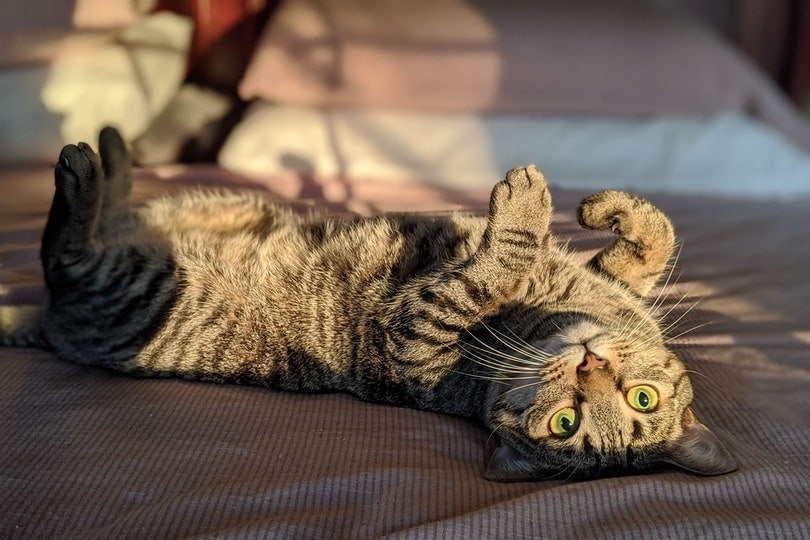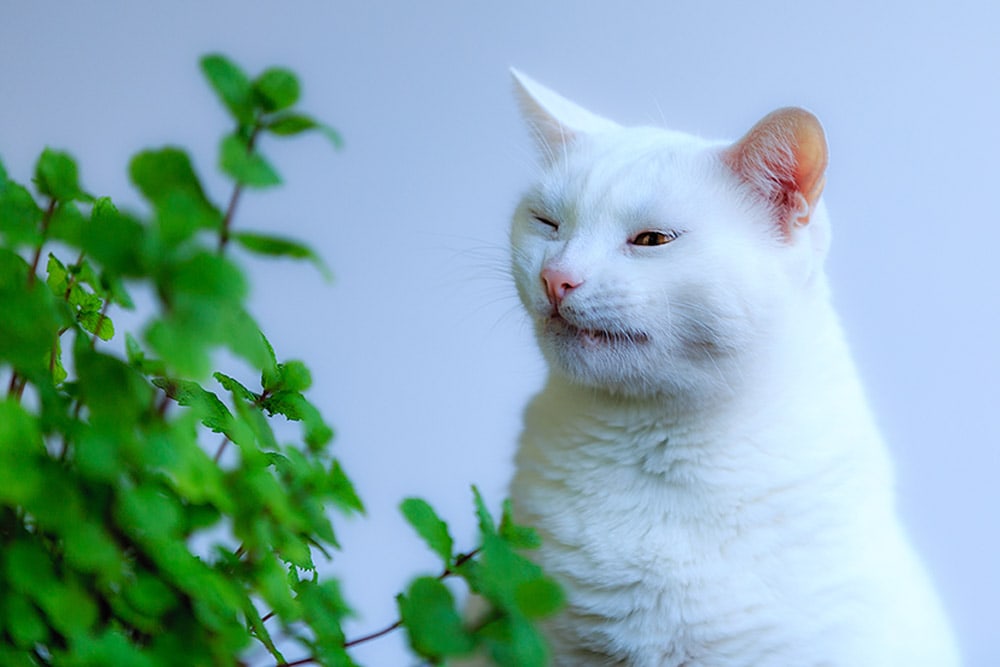How Do Female Cats Act After Mating? Vet Approved Advice

Updated on

The average cat reaches sexual maturity at six to nine months, after which she starts experiencing estrus cycles. Some cats hit puberty earlier, at four months, and are able to conceive kittens at a very young age. The mating season can last all year in specific regions, and females remain “in heat” for about a week on average.
The heat cycle repeats after every two to three weeks, increasing the chances of cats mating and becoming pregnant.
So, can you tell if your female cat has mated? Do female cats act differently after mating?
During intercourse, female cats experience pain caused by the barbs on a male cat’s penis. It is common for them to turn and strike their mate after the act. While male cats flee the scene after mating, females roll around on the ground and appear agitated.
Read on to learn more about the behavior of female cats after mating.
Do Female Cats Act Out of Character After Mating?
Female cats mate up to 30 times in a single heat cycle. While mating takes less than a minute or a maximum of four minutes, it leaves them overwhelmed by hormonal rage.
After mating, female cats become instantly agitated, toss themselves on the ground, and roll. You may also see your cat rubbing her body or face against any hard surface, including the floor, couch, or even your legs. While it may seem awkward, rolling and rubbing against surfaces for a little while is a pretty normal reaction closely related with your cat’s mating pattern.
Female cats roll on the ground after coitus. It is thought that this frantic action helps her cope with the frenzy of hormones and excessive energy. Your pet will also groom with a keen focus on her private parts.
Rolling on the ground to remove the odor of a male cat ensures maximum chances of matting again and producing more kittens in a litter. Generally, female cats are not picky with their mates and are ready for the next tomcat that swings by after about 30 minutes. However, some cats have shown an affinity towards a specific tomcat, and interestingly, some cats don’t like breeding with males of a different breed.

Do Male Cats Also Act Different After Mating?
Male cats don’t show any significant behavioral changes after mating. While they don’t stick around after intercourse, it is mainly because the queens (female cats) deliberately chase them away.
Females experience a rash of hormones after mating and need time to deal with their feelings. While the frenzy period lasts about 10 minutes, and a female is ready to mate again in 30 minutes, most won’t call their mates back immediately.
Most queens take their time to groom and replenish their energy after mating. They only mate three to four times in two days. Because female cats go on heat cycles at the same time, most males roam to try their luck elsewhere. However, they may occasionally return to see if the female is receptive to them again.
Can I Tell if My Female Cat Has Mated?
Mating does not instantly stop the heat cycle. However, mating induces ovulation in female cats. The heat cycle only stops when it’s time for the next phase of the hormonal cycle.
If a cat does not conceive after mating, she will go on heat again after two to three weeks. If she conceives, heat cycles may resume right after delivery. Female cats are seasonally polyestrous and will repeatedly go into heat if they’ve attained at least 80% of their maximum body weight and experience 12 – 14 hours of sunlight or strong light exposure per day. Even a cat nursing a litter of kittens can experience a heat cycle, mate, and get pregnant again if these conditions are met.
Female cats display specific behavioral changes when on heat and after mating. Like all other animals, mating success doesn’t always guarantee that you’ll be getting kittens in eight and a half weeks. Here are other signs that indicate that your female cat has mated.
Behavioral Changes
One of the most notable behaviors of cats after mating is an increase in their desire to rest and nap. This often signifies that your female cat is also pregnant. The once happy-go-lucky cat you once knew may be replaced by a moody pet that cares less about cuddling sessions.
If you notice any unexplained behavioral changes in your cat, it is crucial to consult your vet as soon as possible. You want a good idea about your cat’s situation and ensure she receives what she needs to support the little kittens growing in her womb.

Physical Changes
As their pregnancy progresses, cats may begin to eat more and nap more. It is common for female cats to add some pounds during pregnancy, however this is attributed to the growing kittens; a cat will usually lose non-fetal weight during their pregnancy. If you are still finding it difficult to establish whether your cat mated or is getting fat, you should take her to the vet for a thorough examination.
Nesting involves finding a safe, quiet, and warm place to give birth. It occurs during the final stages of pregnancy when a female cat is just a few days away from delivery. At this point, you’ll also notice that your cat’s nipples appear bigger and more visible.
If you see your cat trying to create cozy spots in a cardboard box or inside a dark cabinet, start preparing yourself to welcome little kittens to your household!
Four Tips to Keep a Pregnant Cat Happy and Healthy
There are numerous benefits of having your female cat spayed. You can schedule for spaying or neutering as soon as your kittens turn eight weeks old. Female cats can be desexed while in heat if a veterinarian determines they are healthy enough for the procedure.
If your female cat is not spayed and gets pregnant, here are four tips to keep them happy and healthy throughout their pregnancy.
1. Provide Proper Nutrition
Once your vet confirms that your female cat is pregnant, it is essential to discuss the unique nutritional needs of a pregnant feline. Generally, pregnant cats need a balanced diet with more calories (same nutritional blend as kitten food). You’ll need to provide more food in smaller portions throughout the day.
Moreover, ensure your pet remains well hydrated and has constant access to clean drinking water. Place water bowls around your home to encourage your pet to take a few sips whenever possible.
While providing our feline companions with high-quality food is paramount, selecting the right food and water bowl is equally important. The modern yet practical design of our Hepper NomNom Cat Bowl combines cat-catered features, like whisker-friendly shallow dishes and slight elevation, with a contemporary style aimed at protecting your floors from messy eating and drinking. The NomNom is entirely dishwasher safe and was thoughtfully created with your cat’s health and well-being in mind.
2. Reduce Household Stress
During pregnancy, your cat will undergo intense hormonal changes that can make them nervous, aggressive, or defensive. These behavioral changes are expected as your pet protects her unborn kittens.
It is necessary to provide a less stressful environment for your cat. Keep your home quiet and isolate your cat from other pets if need be so that she can take frequent naps. Also, give your pet a good round of petting daily and provide plenty of attention and affection (if she welcomes such interactions).

3. Visit Your Vet as Scheduled
Once your vet confirms that your cat is pregnant, you will also receive a schedule for routine checkups. It is crucial to keep up with the recommended vet visits for the expert to assess your cat’s progress. The vet team will also provide information on what to expect when your pet is in labor.
Often, cats don’t need any assistance during delivery. However, it is responsible for you to know what is “normal” and prepare yourself to handle any challenges that may occur. Make sure you rush to an emergency pet clinic if you notice any complications during labor or delivery.
4. Provide a Nesting Area
Your cat may not be worried about where she will birth her kittens right after mating. However, she will start creating a nest a few days before delivery.
You can help by investing in a cat nesting box or building one using a carton and a soft towel or blanket. Place the box in a safe spot away from traffic and entice your cat to use it.
Conclusion
It is standard for female cats to act weird after mating. They react to the hormonal rage released during intercourse by rolling on the ground and rubbing their bodies against hard surfaces.
Female cats act unpredictably after mating. Technically, they are as agitated as they look and can turn aggressive if approached before they cool down. The hormonal rage lasts about 10 minutes, and it’s best to let your cat be as she deals with the hormones rushing through her body.
See Also:
- When Do Cats Go Into Heat After Giving Birth? Our Vet Explains
- Can Cats Be Gay? Behavior, Reasons, & FAQ
Featured Image Credit: bombermoon, Shutterstock












